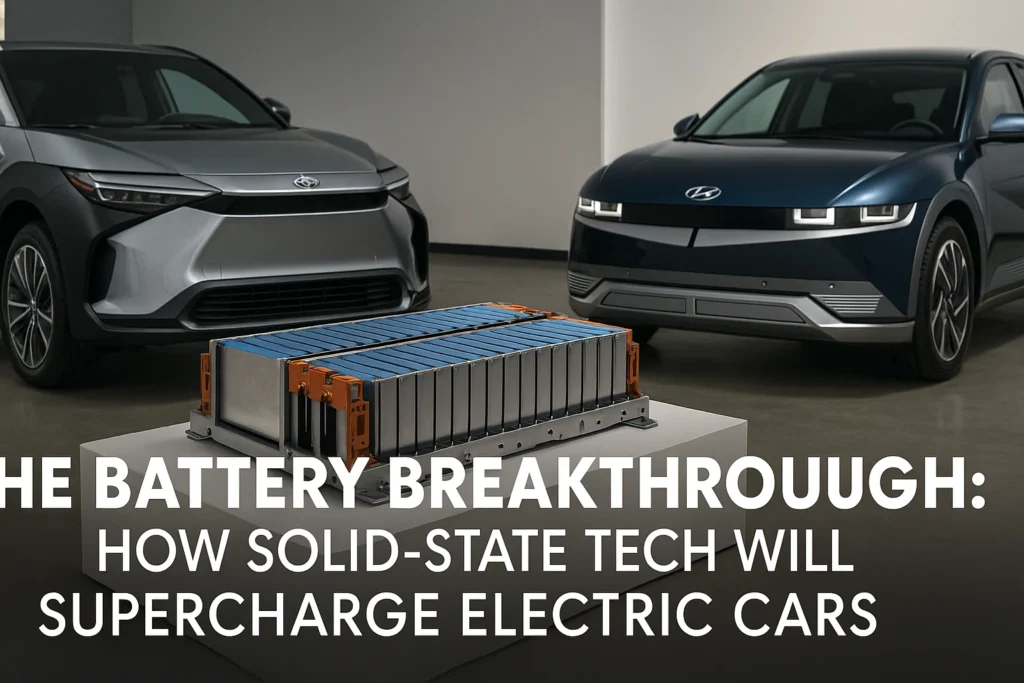For years, the electric vehicle (EV) revolution has been gaining momentum, quietly reshaping our roads and imaginations. Yet, a persistent hum of questions remains: “How far can it go on a single charge?” and “How long does it take to refill the ‘tank’?” These are the fundamental challenges that have kept some drivers on the sidelines, clinging to the familiar hum of gasoline engines. But a monumental shift is now on the horizon, one poised to silence these concerns and truly supercharge the EV market: the arrival of solid-state battery technology.
Imagine an electric car that can travel hundreds of miles further, recharge in minutes rather than hours, and boasts a level of safety unmatched by today’s batteries. This isn’t a distant dream anymore; it’s the promise of solid-state batteries, and automotive giants like Toyota and Hyundai are leading the charge, rapidly moving these innovative power sources from the lab to advanced production lines, with the first vehicles expected to hit the market in the very near future. This breakthrough isn’t just an incremental improvement; it’s a fundamental reimagining of what an electric car can be.
The Lithium-Ion Era: Powering the First Wave of EVs
To understand the magnitude of the solid-state revolution, it’s important to first appreciate the technology that got us here: the lithium-ion battery. For decades, these batteries have been the workhorses of the portable electronics world, powering everything from our smartphones to laptops. When the electric vehicle market began to surge, lithium-ion was the natural choice.
How Lithium-Ion Batteries Work:
At their core, lithium-ion batteries consist of a positive electrode (cathode), a negative electrode (anode), and a liquid electrolyte in between. During charging, lithium ions move from the cathode through the liquid electrolyte to the anode. When discharging (powering the car), they move back to the cathode, releasing energy.
Their Contributions and Limitations:
Lithium-ion batteries have been instrumental in making EVs a reality, offering good energy density (how much energy they can store for their size and weight) and decent power output. They’ve enabled impressive ranges for many EVs and continue to improve. However, they come with certain inherent limitations:
- Range Anxiety: While improving, current EV ranges still don’t match the convenience of gasoline cars for long trips, leading to “range anxiety.”
- Charging Times: Even with fast chargers, topping up a large EV battery can take 30 minutes to over an hour, a significant wait compared to a quick gas station stop.
- Safety Concerns: The liquid electrolyte is flammable, posing a risk of thermal runaway (overheating leading to fire) if the battery is damaged or manufactured improperly. This requires complex cooling and battery management systems.
- Degradation: Over time and with repeated charging cycles, lithium-ion batteries naturally degrade, reducing their capacity and range.
- Material Costs: The reliance on certain critical raw materials like cobalt and nickel, which can have volatile prices and supply chain issues, is another ongoing challenge.
These factors have created a natural ceiling for lithium-ion performance. Enter solid-state technology, promising to shatter that ceiling.
Solid-State: A Fundamental Leap in Battery Design
The core innovation of a solid-state battery is right in its name: it replaces the flammable liquid or gel electrolyte found in traditional lithium-ion batteries with a solid material. This seemingly simple change unlocks a cascade of dramatic improvements that could redefine electric vehicles.
How Solid-State Batteries Work (The Simplified Version):
Instead of ions moving through a liquid, they move through a solid material, which acts as both the electrolyte and the separator. This solid electrolyte can be made from various materials, including ceramics, polymers, or sulfides. This allows for several key advantages:
- Higher Energy Density: Without the need for bulky separators or complex cooling systems, solid-state batteries can pack more active material into a smaller, lighter space. This means significantly more energy can be stored in the same volume, translating directly into longer driving ranges for EVs – potentially exceeding 700 miles on a single charge.
- Faster Charging Speeds: The solid electrolyte can facilitate faster ion movement and withstand higher currents, allowing for incredibly rapid charging. Imagine an EV that can charge from 10% to 80% in 10-15 minutes – rivaling the time it takes to fill a gas tank.
- Enhanced Safety: Eliminating the flammable liquid electrolyte dramatically reduces the risk of thermal runaway and fire. This makes solid-state batteries inherently safer, reducing the need for extensive safety features and offering greater peace of mind for consumers.
- Longer Lifespan: Solid electrolytes are generally more stable and less prone to the chemical degradation that affects liquid electrolytes. This means solid-state batteries are expected to have a significantly longer cycle life, maintaining their capacity and performance for a greater number of charges.
- Lighter Weight: The denser energy packaging and reduced need for safety components can lead to lighter battery packs, which improves overall vehicle efficiency and performance.
These combined benefits represent not just an evolution, but a true revolution for the electric vehicle, addressing the very pain points that have slowed mainstream adoption.
Toyota’s Long Road: Pioneering the Solid-State Future
Toyota, a company often seen as a pioneer in hybrid technology but a latecomer to pure EVs, has paradoxically been one of the earliest and most persistent champions of solid-state battery research. They hold a vast number of patents in the field and have invested decades into making this technology a reality.
For years, Toyota’s deadlines for solid-state battery commercialization have shifted, reflecting the immense engineering challenges involved. However, as of mid-2025, their progress is more concrete than ever. Toyota’s current target for commercial deployment or mass production of solid-state batteries is now widely cited as 2027 or 2028.
Their strategy involves:
- Partnerships for Materials: Collaborations with companies like Idemitsu are focused on mass-producing solid electrolytes, a critical component. A new facility for this purpose is expected to be operational by late 2027.
- Demonstration Vehicles: Toyota has already showcased prototype solid-state battery cells and vehicles, demonstrating impressive capabilities. They are aiming for vehicles with ranges of up to 745 miles (1,200 km) on a single charge, a figure that would truly put range anxiety to rest for most drivers.
- Focus on Core Technology: Toyota believes that solid-state batteries are crucial for EVs to achieve mass adoption, indicating their long-term commitment to this technology as a cornerstone of their future electric lineup.
While not on the market yet, Toyota’s consistent, long-term investment positions them as a leading contender to bring this transformative technology to a mass scale in the coming years.
Hyundai’s “Dream” Battery: A Bold New Contender
Not to be outdone, Hyundai has rapidly accelerated its own solid-state battery development, with a project ambitiously dubbed the “Dream” battery. The South Korean automotive giant is making significant strides in bringing this next-generation power source into its EV lineup.
A major milestone for Hyundai occurred in March 2025, with the public unveiling and operational launch of its all-solid-state EV battery pilot production line. This facility, located at Hyundai’s new research center in Uiwang, South Korea, is crucial for refining the manufacturing processes and testing the viability of solid-state cells on a larger scale.
Hyundai’s timeline is aggressive:
- Prototype Vehicle by Late 2025: The company expects to reveal its first prototype vehicle powered by its solid-state battery technology by the end of 2025. This will be a significant real-world test, moving beyond lab results to demonstrate the battery’s performance in an actual EV.
- Mass Production by 2030: While initial deployments might be smaller scale, Hyundai is targeting mass production around 2030, with the first commercial EVs featuring these batteries hitting the market shortly thereafter.
Hyundai’s “Dream” battery initiative is part of a broader $9 billion battery investment strategy, aiming to secure in-house battery production and leadership in advanced EV technologies. By developing their own solid-state batteries, Hyundai seeks to gain a competitive edge in range, charging speed, and safety, potentially reducing reliance on external battery suppliers.
Navigating the Roadblocks to Mass Production
Despite the incredible promise and the significant progress made by companies like Toyota and Hyundai, bringing solid-state batteries to widespread mass production is no small feat. The journey from laboratory breakthrough to millions of vehicles on the road is paved with complex engineering and manufacturing challenges:
- Manufacturing Complexity and Cost: Producing solid electrolytes requires entirely new, highly specialized manufacturing processes that are very different from those used for traditional lithium-ion batteries. This includes creating extremely thin, defect-free layers of solid material and ensuring perfect contact at the interfaces between the solid electrolyte and electrodes. These processes are currently more expensive and harder to scale up, making solid-state batteries 2-3 times more costly to produce than lithium-ion batteries today.
- Material Challenges: While solid electrolytes offer safety benefits, some types (like sulfide-based ones) are sensitive to moisture and require costly “dry room” manufacturing environments. Additionally, ensuring the stability and preventing the formation of lithium dendrites (needle-like structures) at the lithium-metal anode interface remains a critical hurdle, as dendrites can short-circuit the battery.
- Mechanical Stability and Brittleness: Many solid electrolytes, particularly ceramics, can be brittle. This makes them difficult to handle during manufacturing and raises concerns about their durability in real-world automotive applications, where batteries are subjected to vibrations, impacts, and temperature fluctuations.
- Thermal Management: While safer, solid electrolytes are less efficient at dissipating heat than liquid ones. Maintaining optimal operating temperatures, especially during rapid charging or in extreme climates, requires sophisticated thermal management systems.
Overcoming these challenges requires continuous innovation in materials science, manufacturing techniques, and cost reduction strategies. Billions are being invested globally to solve these problems, and the projected timelines for mass production (2027 for partial, 2030 for full-scale) reflect the intense effort required.
The Supercharged Future of Electric Mobility
The integration of solid-state batteries into electric vehicles promises to redefine the landscape of personal transportation. This isn’t just about incremental improvements; it’s about unlocking a level of performance and practicality that could finally convince the most skeptical drivers to make the switch to electric.
Imagine a world where:
- Range Anxiety is a Relic: EVs regularly travel 500, 600, or even 700 miles on a single charge, making cross-country trips as seamless as in a gasoline car.
- “Refueling” is Instant: Pull into a charging station, plug in, grab a coffee, and in 10-15 minutes, you’re ready to go again, eliminating long waits.
- EVs Are Safer Than Ever: The risk of battery fires is dramatically reduced, enhancing consumer confidence and lowering the overall safety profile of electric vehicles.
- Batteries Last for Decades: The extended lifespan of solid-state batteries reduces concerns about degradation and the long-term cost of ownership, making EVs a more sustainable investment.
- Lighter, More Efficient Cars: Reduced battery weight contributes to better handling, improved acceleration, and overall energy efficiency, making EVs even more enjoyable to drive.
While challenges remain, the progress made by industry leaders like Toyota and Hyundai, alongside other global players, indicates that the solid-state battery revolution is not a matter of “if,” but “when.” The mid to late 2020s are poised to be the years when these cutting-edge power sources transition from the laboratory to our driveways, truly supercharging electric cars and accelerating the world’s journey towards a sustainable future.



